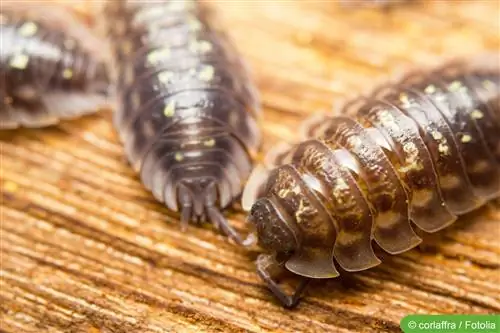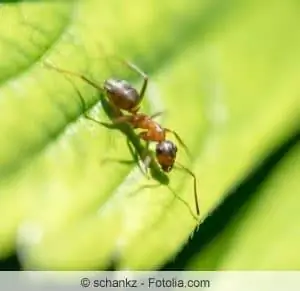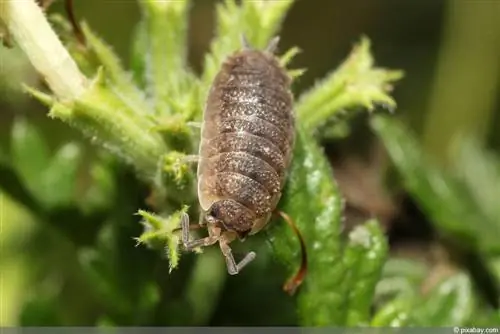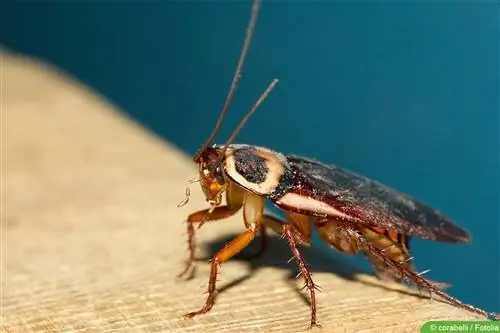- Author admin [email protected].
- Public 2023-12-17 03:39.
- Last modified 2025-01-24 12:45.
In many eyes, woodlice and cockroaches are a sign of poor hygiene. But woodlice can nest not only in a dirty apartment, but also in very clean and hygienic houses and cause discomfort for the homeowner.
How to get rid of woodlice in your house and apartment
The woodlice, also known as the woodlice, lives where it is warm and moist. For this reason, it is primarily found in the bathroom or kitchen, but less so in the living room or bedroom. Food lying around or poorly stored can also be a cause for woodlice to settle in your own home. Where the woodlice finds warmth and moisture, but not wetness and enough food, it will stay and multiply very quickly.
How does the woodlice get into the apartment?
Every homeowner asks themselves this question when they clean, empty out the closet, or happen to see a woodlice. The chitin shell alone gives you goosebumps all over your body and calls all hygienic aspects into question. But this is a mistake. Just because there are woodlice in the house doesn't mean you have to live in dirt and consider poor hygiene as the reason for their settlement. This thought, which is spontaneously and traditionally transmitted, excludes the possibility of finding out about the real cause and getting to the bottom of it. Damp walls can be a cause. The woodlice also magically attracts food, such as dog or cat food in a bowl, which is preferably placed in the kitchen. Since woodlice are group animals, an animal will rarely be found alone. If you discover a woodlice, you can immediately assume there is an infestation and be prepared for the pests to have taken hold in larger numbers.
Prevention - this is how you make your apartment unattractive for woodlice
Avoiding moisture is one of the most important criteria in prevention. The animal will not stay in a dry room because it does not have the conditions it needs to live. Regular ventilation is also one of the measures that prevent woodlice from moving into the house. Fresh air and the absence of moisture deprive the woodlice of two important things that make up their lives and that they need to survive. In the cool season, it is advisable to ventilate the room quickly, as permanently opening the windows can cause damp rooms and thus negate the actually well-intentioned improvement of the indoor climate. Good insulation of the house is an important part of preventing woodlice from settling. Since the causes can be found not only in the house, but also in the basement, on the balcony or on the terrace, you should be careful here too.
- Never place flower pots directly on the ground as moisture forms underneath.
- On wooden floors, avoid cracks that attract moisture.
- Seal pipes that lead into the basement and avoid gaps in the masonry around the pipe.
These tips are helpful in the house itself:
- Air after showering or bathing.
- Never place bath mats and wet towels on the floor.
- Ventilate in winter.
- Do not dry laundry in closed basement rooms.
The natural control of woodlice
Even if the disgust for a woodlice is very high, you should not consider the chemical club. With helpful natural remedies and the right use, it is possible to spoil the woodlice's habitat and remove them from the house, even without chemicals. First of all, it is important that all preventive measures are taken immediately to ensure that the pests' cozy habitat is not destroyed. Since the woodlice have already moved in, the following measures will help combat them:
- attach an adhesive strip in places where the woodlice are seen more often (woodlice sticks)
- Put the spirit in a small bowl or on a shallower plate so that the woodlice can find preferred food there and can be easily taken outdoors
- Build food traps: Place potatoes, overripe fruit or vegetables in a shallow bowl.
In order to lure woodlice into a feeding trap, all food in the house and apartment must be placed out of the reach of the annoying animals. The food trap attracts them, but only if they cannot find food anywhere else more easily and can therefore freely circle around the food trap provided. The food trap is very effective in combination with adhesive strips. If some woodlice move away from the plate, they will stick to the adhesive strip and have no chance of escaping.
Pest infestation or sign with warning effect
In no house is the woodlice considered a welcome guest. But anyone who overcomes their disgust and sees the arrival of the woodlice as a warning signal will in most cases benefit from it positively. Where woodlice live, it must be moist. The animals also increasingly settle in rooms where moisture leads to the formation of mold. In general, the woodlice in the house is a sign that you should check the insulation, look for holes in the masonry and rethink your ventilation. It is not uncommon to come across a cause that would probably have been overlooked for a long time if the woodlice had not appeared.
Even if the animal has shown the homeowner the way to a source of damage, you obviously don't have to give the woodlice asylum and you can banish it from the house using the methods listed above. The fight against the small animals will certainly be carried out much more carefully, as this has resulted in the discovery of problems in the house and without the woodlice there would have been a risk of overlooking damp walls or cellars, as well as other causes for the colonization of woodlice.
If you discover a woodlice in the house, you should immediately start looking for the cause. At the same time, you can show the animal the way outside in a natural and harmless way and banish it from your house using the methods listed above.
What you should know about woodlice in brief
External features and special features
- When fully grown, woodlice grow up to 15 mm in size and range in color from light gray to dark gray, almost black. The body is flattened.
- Islices are shy of light and active at night. They also need moisture on their underside, which is why they seek out damp places, especially during the day.
- Otherwise they are not able to breathe at all because their gills are on their underside.
- The isopods have left the water as land isopods and also have lungs, but beyond that they only cover five percent of their breathing.
- The female woodlice lays her eggs directly in her breast pouch, these can be up to a hundred animals in a year, and their offspring then develop there.
- The young animals hatch from the eggs and only leave their mother when they can lead an independent life.
- Islice are among the animals that are useful humus producers. However, only small populations are welcome in the garden.
- And in the basement they don't appreciate them at all. They particularly seek shelter behind shelves, under flower pots, stones and between potatoes.
- They generally like to be near plants and materials that are stored in damp conditions.
Causes
Islice can cause damage if there is not enough food available. Since they feed on plants, in addition to leaves, fungi and dead plant remains, they sometimes eat young plants (especially if there are larger populations of woodlice). This is particularly common in greenhouses. In cellars they also eat fruit, potatoes, flower tubers, tomatoes, lettuce and all other vegetables. Especially when the shell is injured or other animals - mice and snails, for example - have already caused damage by eating them.
Control and prevention
- The woodlice's natural enemy is the toad. But since not everyone has, or wants to have, a toad in their cellar or garden, there are various other options for combating woodlice. Basically, damp areas should be avoided. However, this is not entirely feasible if you have potted plants on the terrace. However, it is possible to place the terrace slabs on split or place the potted plants on special pot feet so that air can circulate underneath and the irrigation water can drain and evaporate unhindered.
- Traps that can be set up to quickly get rid of the woodlice are also recommended. Hollowed out potatoes or banana peels and orange peels are ideal. The woodlice like to gather there and can then be removed in whole groups. Clay pots that are filled with damp wood shavings act as traps. It is also conceivable to fill a fruit brandy into a flat bowl and set it up. Placing a damp bag is also a tried and tested method. The entire brood is then disposed of along with the sack.






